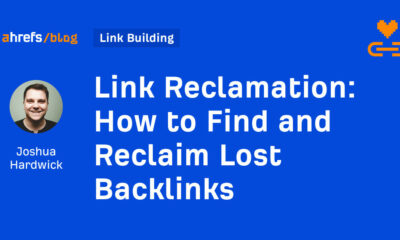SEO
How to Find Influencers

Do you want to find the right influencers for your business?
In this blog post, we will walk you through a step-by-step guide on how to find the best influencers for your brand. We’ll cover everything from defining your goals to tracking the progress of your campaign.
Define your goals
The first step in finding the right influencers is defining your goals. Here are some questions to answer:
- Why do I want to work with influencers?
- What am I hoping to achieve?
- Do they align with the goals I have set up in my marketing plan?
- How much are we willing to spend for this collaboration?

Download: Quarterly Marketing Plan
By answering these questions, you ensure that it is crystal clear what your goals are and what role they play in your overall marketing plan, how the influencers can help you achieve them, and what you can offer in return for a fair collaboration.
For example, let’s say you’re in the health and fitness niche and your target audience are moms. Let’s answer the questions above.
- Why do I want to work with influencers?
The health and fitness niche is competitive and most of our competitors offer supplements or vegan alternatives. I offer a monthly subscription service where the customer will get a supply of vegan frozen meals every week. This can break into the market faster if I tap the right people to test and review them.
- What am I hoping to achieve?
Greater visibility and word-of-mouth marketing for my business.
- Do they align with the goals I have set up in my marketing plan?
Yes. I aim to sell at least 50 subscriptions for the first month to break even. Influencer marketing plays a significant role in achieving this goal.
- How much are we willing to spend for this collaboration?
$350 for a YouTube review with additional fees for Instagram and Tiktok posts depending on engagement and follower count.
Check industry pricing
Before you even start looking for influencers, you need to understand how the fees work. Fee structures for influencers may differ from country to country.
For example, a fee structure (or rate card) can look like this:

Or you can check industry rates and how they’re computed such as this guide by Get Hyped if you’re in the US.
Then edit your answer to the last question (How much are we willing to spend for this collaboration?) based on your findings.
This ensures that:
- You understand the type of influencer you can afford to collaborate with (nano, micro, etc.) so you can narrow down your research.
- Negotiations can be smoother because you already have an idea of how much you’re willing to spend and you understand how the fees work—haggling prices isn’t a good look for your brand because these influencers work hard to build and engage their audience base.
Research to find relevant influencers in your niche
Once you have defined your goals and checked the pricing, it’s time to find influencers.
Social media listening tools are a great way to find relevant influencers. These platforms allow you to track mentions of competitor brands so you can see who they’re working with. You can then look for influencers in that circle.
You can also use social media listening tools to track relevant hashtags. This is a great way to find influencers who are talking about topics that are important to your business.
Some of the most popular social media listening tools include Cloohawk and Buzzsumo.
Further reading: Social Listening vs Social Monitoring
As mentioned, you can find relevant influencers by identifying relevant hashtags. Hashtags are a great way to find people who are talking about specific topics.
Here’s a trick: find a famous influencer in your niche that’s out of your budget and check their hashtags. Then enter that hashtag into a free tool like Social Searcher to see who is using the same hashtag.

You can also opt to go on the platform you want to have the most visibility in and manually search the hashtags there. For example, you can go on Instagram and use #veganmom or #veganphilippines to narrow your search.
Use tools to find their contact details
There are various ways to contact influencers, and it usually is pretty easy to reach out to them.
More often than not, they are looking for opportunities to collaborate with brands, so their DMs are open, or their emails are in their bio or video description.
It’s a bit tedious to manually reach out to a bunch of influencers though especially if you’re trying to work with a lot of them.
NinjaOutreach
For that issue, check out NinjaOutreach.

NinjaOutreach is an outreach software used by digital marketing agencies, bloggers, and small businesses wanting to grow their online presence.
What’s great about this tool is that with a simple keyword search, you can find online influencers in your niche and see valuable information about them at the same time.
In this way, you can easily partner with influencers who are interested in promoting your brand to their audiences.
Although NinjaOutreach has a number of interesting features, we’re going to focus on two for this post:
Social media influencers finder
Interestingly, here’s what NinjaOutreach’s dashboard looks like when you log in:

On the left side of the dashboard, you will find Instagram, TikTok, and YouTube Influencers.
When you click on the Instagram Influencers tab, you can start searching for Instagram influencers by their username or keywords.
You can use the filter or sorting feature found on the left side of the dashboard if you want to narrow down your search.
Email Finder
Another NinjaOutreach’s cool feature is the email finder, where you can find someone’s email address by searching for a specific person and domain.
Use this feature if you’re looking to do any of the following:
- Guest post outreach
- Product review outreach
- Instagram influencer sponsorship
- Link building outreach
- Sponsored post outreach
- Expert roundup post outreach
- Podcast/Interview outreach
But what if the influencer you’re eyeing doesn’t have their contact information on their social media or website?
Here are other options you can look into:
Findthat.Email
Findthat.Email is a straightforward service. You enter an influencer’s name and their company or website and the email finder will give you their contact details. I can’t emphasize enough how easy it is to use.
The best part about this is the website allows you a few free sample searches on the main page.

This screenshot was taken directly from their homepage and the sample person I tried to find was Bill Gates of Microsoft.
While Bill Gates may not exactly be the ideal example of a hard-to-find person, the example is still a good enough one to demonstrate what Findthat.Email’s service is all about.
I tried looking for other less exposed influencers and I was impressed. The website gave me what I wanted. It does have its limitations, such as needing the domain or website so you can perform search. If you don’t have that info, it would be better to use another tool.
Here are the tool’s features:
Search/Verify
Findthat.Email sifts through a huge chunk of data freely available on the internet and delivers results—all in a matter of seconds.
Bulk Search
Another nifty feature is having the ability to search in bulk. Simply upload a list of people and the service will look through their database and will simply notify you when the search is done. No limit was ever explicitly specified but we did try at least 10 at one point and the search was done in a matter of minutes.
Chrome Extension
One of the best features of Findthat.Email is the ability to have it installed on Google Chrome. It makes finding prospects on any social platform easy and in an instant.
Integrations
This is frankly my favorite feature. I’m all about using a lot of tools and Findthat.Email allows you to sync your contacts with your other tools such as Salesforce, MailChimp, Zoho CRM and PipeDrive to name a few.
Hunter
Hunter.io is another popular email tool that lets you find professional email addresses from domains or companies.
What makes Hunter popular among marketers, business owners, and recruiters is that it’s straightforward, which makes it a very easy tool to use.

When you sign up for their free account, you will have access to Hunter’s following features:

Domain Search
The domain search lets you find email addresses using one given domain (example: “seo-hacker.com”) and other publicly available email addresses.
You can use up to 25 searches per month with a free account. This number applies to other Hunter’s features as well.
Email Finder
This feature lets you find email addresses using the full name and the domain name used for email by the company or organization. When you enter the company name into the Email finder, Hunter will automatically suggest the closest domain name.
Author Finder
This feature is found right next to the Email Finder tab. It allows you to find the author of an article and their professional email address.
To find the author’s email address, simply provide the article URL and you’re good to go.
Email Verifier
If you want to check whether the email address exists and can receive emails, you can use this feature.
This feature is extremely helpful especially if you want to verify an email address, so you can protect your sender’s reputation and avoid bounces at the same time.
Instant Checkmate
Coming out of left field, but a surprisingly useful tool for those in the US—Instant Checkmate.

Instant Checkmate is an online background check service that lets you instantly search public records. They have four search themes you can use:
- People Search
- Reverse Phone Lookup
- Criminal Records
- Inmate Search
But for our purposes I want to focus on the first one—People Search.

According to their website, “Some of the information that you can find with Instant Checkmate includes addresses, criminal and traffic records, e-mail addresses, phone numbers, social media accounts, and much more.”
So you can use it not just to perform background checks on the influencers (who reside in the US) you want to connect with, but also to find their contact information if they aren’t posted on their social media accounts or website.
Important: Make sure to add your influencers to a spreadsheet for easier tracking.
Craft your pitch
Before you reach out to your influencer list, make sure you craft your pitch. Write down their deliverables and project timeframe, and ask for their rate card so you can confirm with your budget.
Don’t forget to personalize your messages. Mention something that you liked about their content, and explain how it would fit with your brand. Be friendly and genuine, and don’t be afraid to ask questions.
Here’s a sample pitch you can edit:
Hello, <INFLUENCER>!
This is <YOUR NAME> from <COMPANY>, the <POSITION> for this project. I’m happy to report that <COMPANY> wants to collaborate with you as one of their influencers for <PROJECT>.
We have checked your profile and we’re genuinely interested in working with you. 🙂
Here are the deliverables:
<PROJECT>: <DELIVERABLE>
Timeline: <INSERT TIMELINE>As for a sample execution, kindly refer to the attached brief.
Kindly submit your rate card so we can make our offer. Once we’ve confirmed our partnership, we will send another email asking for your details so we can send the free premium items that will be featured in the deliverables.
Feel free to reach out to me through this email or via <CONTACT DETAILS> if you have any questions.
I’ll wait for your acknowledgement. Thank you and have a great day, <INFLUENCER>!
Sincerely,
<YOUR NAME>
Reach out to your influencer list and pitch your product or service
Once you’re done with your pitch, it’s time to start reaching out. Again, don’t forget to personalize your message!
Move your way down your spreadsheet and indicate if you’ve already reached out to the influencer, then start noting the following:
- If they responded to your pitch
- What their rates are
- If they have any requests
- If you’ve sent them the partnership confirmation email
- If the deal is sealed
This helps ensure that you’re on top of everything and you have all the information you need in one document.
Negotiate a deal that benefits both parties
When it comes to working with influencers, the key is to negotiate a partnership that is mutually beneficial. After all, both parties are looking to achieve specific goals and objectives.
When you get a response to your pitch, be sure to listen carefully to their feedback and ideas. Once you have a good understanding of what they are looking for, it’s time to negotiate the terms of the partnership.
Be sure to be clear about what you can offer in terms of compensation and creative freedom. By taking the time to negotiate a fair and balanced partnership, you can ensure that everyone involved walks away happy.
Track the progress of your campaign and analyze the results
Finally, once you’ve found a few influencers who are a good fit for your brand, it’s important to keep track of your progress.
Make sure to measure the results of your campaigns, so you can see what’s working and what isn’t. This will help you adjust your strategy moving forward, and ensure that you’re getting the most out of your influencer partnerships.
Don’t forget to acknowledge your influencer partners for their hard work. A little relationship building always goes a long way.
Key takeaway
Have you tried finding influencers before? Let me know how this works for you! To get the most out of an influencer marketing campaign, it’s important to do your research and put in the effort to find relevant contacts.
Luckily, we’ve outlined all of the steps you need to take to find and secure a successful partnership with an influencer. By following these guidelines, you can maximize your chances of reaching your target audience and achieving your business goals.
So what are you waiting for? Get started today!



















You must be logged in to post a comment Login